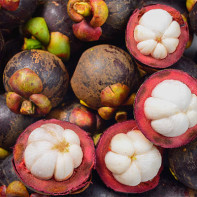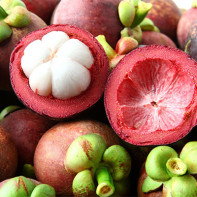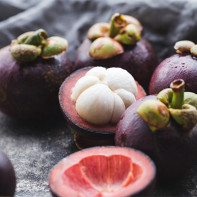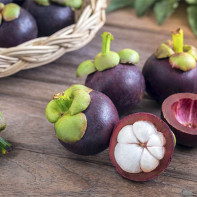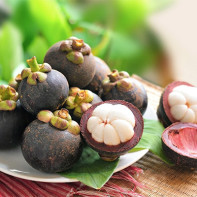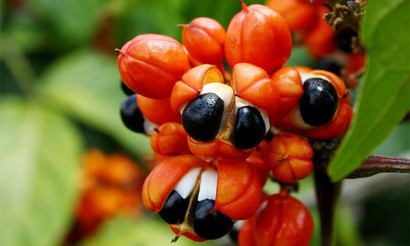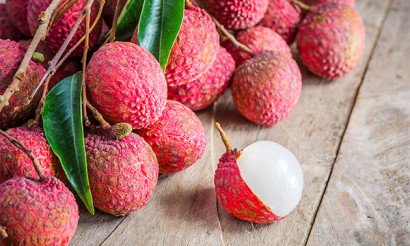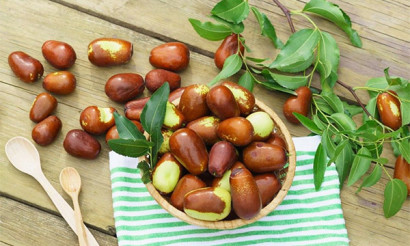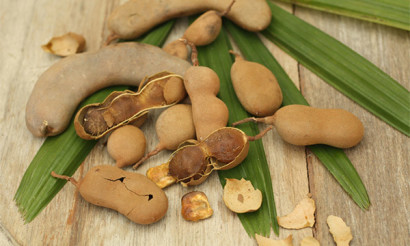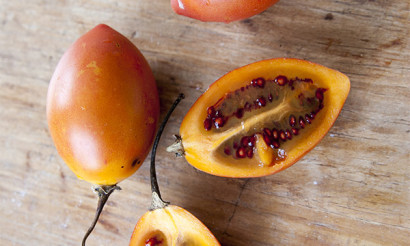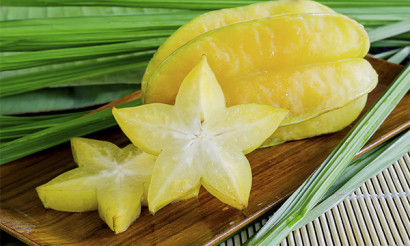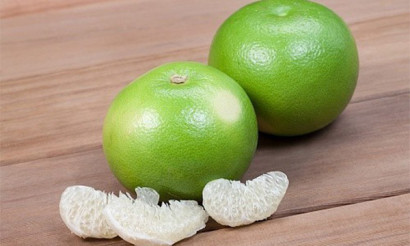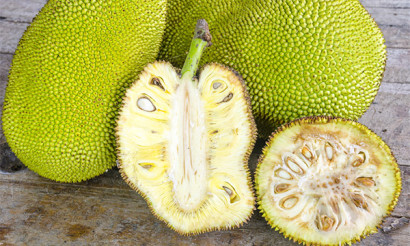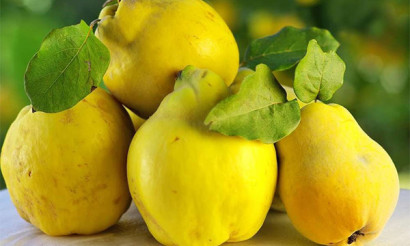Mangosteen: benefits and harms to the body
Mangosteen is an exotic fruit that has many names. Sometimes it is called mangosteen, mangosteen or mangkut. It belongs to the Kluziev family and is a close relative of the Garcinia Cambogia - a fetus that is very actively used in dietetics today to get rid of excess weight.
- What is mangosteen and how does it look
- Composition and calorie content
- Useful properties of mangosteen fruit
- General benefit
- For women
- For men
- During pregnancy
- When breastfeeding
- For kids
- When losing weight
- Mangosteen in folk medicine
- Application in cosmetology
- Cooking Application
- Fruit salad
- Mangosteen Smoothie
- Mangosteen Jam
- Mangosteen Sauce
- Three tastes mangosteen salad
- Thai salad with mangosteen, shrimp and pork
- Mangosteen sorbet
- Harm and contraindications
- How to choose and store
- How to clean and eat mangosteen
- Can I eat bones
- Interesting Facts
What is mangosteen and how does it look
This fruit is a mangosteen tree fruit. In the wild, it grows in Indonesia, but its homeland is unknown. Currently, mangosteen trees are cultivated in Thailand, on the island of Sri Lanka, in Malaysia, that is, mainly in Southeast Asia. However, there is evidence that it is grown in Honduras.
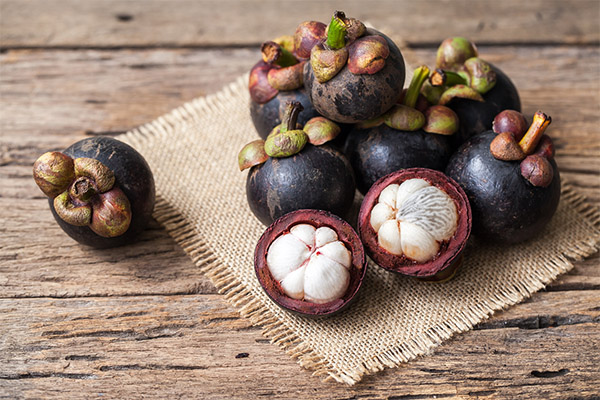
A feature of the mangosteen tree is that it grows very slowly, and begins to bear fruit on average only in the ninth year of life. But then it brings two crops a year. It grows very high - up to 6–25 m, has a straight trunk covered with dark brown, sometimes even almost black bark with a scaly structure. Crohn's pyramidal.
The bark contains a resinous bitter substance, which can be called natural latex. Mangosteen is an evergreen plant whose branches are covered with oblong-lanceolate leathery leaves. Interestingly, the old leaves are dark green, slightly shiny at the base, and the new ones grow almost pink.
The flowers of the mangosteen tree are quite large, up to 5 cm in diameter, and they grow in groups at the ends of the branches and have a rather bright color of oval petals - with red, yellow, green spots and a border.
The flowers fall quickly, and round-shaped fruits appear on the trees. Outside, they are smooth, their diameter can be 3.5–7.5 cm. The fruits are covered with a dense peel, which usually has a very rich shade - from red-purple to dark purple. The thickness of the peel is 6–10 mm. The pulp inside is snow-white, sometimes slightly pinkish, juicy, divided into 4–8 lobules. Seeds may not be inside, but sometimes they still exist - small, oblong, slightly flattened.
The pulp of the fruit has a delicate aroma, and although in all reference books its taste is described as sour-sweet, in fact it is more complex. It contains notes of citruses, pineapples, nectarines and strawberries, so it is almost impossible to describe it in a single word.
Composition and calorie content
Mangosteen has a relatively low energy value. It contains only 73 kcal per 100 g.
The pulp and peel have a different chemical composition. The complex sweet and sour taste of the pulp is explained by the fact that it contains a lot of acids (pH is about 3.5 units). But at the same time, it contains a lot of sugars - with fructose accounting for 2.4% of the volume, slightly less - for glucose, and sucrose is in the lead (about 10%).
The composition of the pulp includes such substances:
- B vitamins, including folic acid, which participate in the metabolism and at the same time normalize the functioning of the nervous system.
- Ascorbic acid, which in itself is a powerful antioxidant, also improves the state of blood vessels.
- Vitamin E with anti-inflammatory properties and beneficial effect on the reproductive system.
- Minerals - potassium, sodium, iron, iodine, zinc, fluorine, etc.
In general, the flesh is only about 30% of the total weight of the fetus, all the rest falls on a dense peel. She has a bitter taste. The peel contains flavonoids (xanthones), the anti-oncological properties of which are being actively studied at various universities, and pectin. The tannins contained in the peel give it a bitter taste and have an astringent effect. Therefore, in Asian countries, the skin of this fruit is used for diarrhea and various gastric diseases.
Useful properties of mangosteen fruit
General benefit
The unique composition of mangosteen, as well as the fact that it has practically no contraindications for use, makes it a very promising raw material for the pharmaceutical industry. Moreover, not only the pulp of the fruit, but also its skin has useful properties. In the old days, infectious diseases of the urinary tract were treated with drugs based on it. In addition, the leaves and bark of the tree are used in pharmacology and traditional medicine.
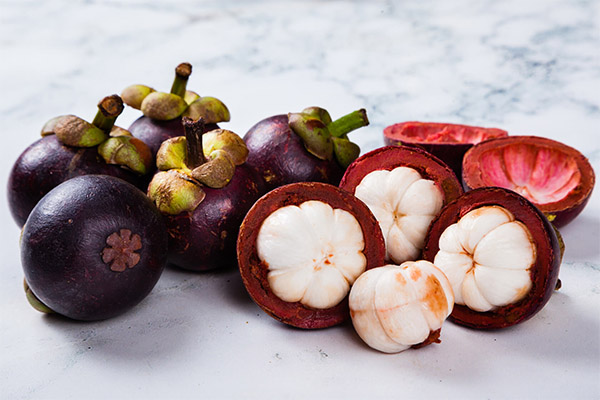
The fruit itself has the following beneficial properties:
- Antibacterial effect. The xanthones contained in its peel provide protection against pathogenic microorganisms. It is believed that they are effective against certain types of fungus.
- Anti-inflammatory effect. It is due to the presence of a large number of flavonoids, of particular importance in this case are anthocyanins, giving the peel an intense lilac hue. They have the most pronounced anti-inflammatory properties. Due to this, peel extract is used to treat arthritis and other similar diseases.
- Strengthening immunity due to the high content of vitamins C and E.
- Improvement of the cardiovascular system due to the presence of ascorbic acid and potassium.
- Normalization of cerebral circulation.
- Improvement of digestive processes (moreover, mangosteen helps to get rid of gastrointestinal disorders).
- Acceleration of metabolic processes.
- Effective cancer prevention.
The substances contained in the pulp and peel help get rid of headaches and help normalize sleep. In addition, xanthones, which are present in large quantities in the peel, help improve mental activity, and also perform the function of adaptogens, that is, they help the body adapt to environmental conditions. Pectins, also found in the peel, maintain microbiological balance in the intestines.
For women
For the fair sex, mangosteen is useful for its anti-inflammatory properties - this allows you to get rid of various diseases of the pelvic organs. In addition, it contains substances that contribute to the normalization of the menstrual cycle. A large amount of iodine allows you to fight some diseases of the thyroid gland. Vitamin E is effective in the treatment of diseases of the reproductive system.
There are studies that prove that mangosteen can fight premature aging. Extracts from the pulp of this fruit and its peel help retain moisture in the skin and prevent dehydration. In addition, they have a mild antibacterial effect, protect the skin from colonization by pathogenic microbes.
Studies of the reparative properties of mangosteen have also been conducted in Belgium. In particular, it was proved that skin treated with preparations based on its extracts was restored faster than after using conventional products containing vegetable oils and silicones.
For men
Among the xanthones (and there are more than 60 of them in the mangosteen), relatively recently, one was identified, which was called alpha mangosteen. It was proved that it not only normalizes the level of glucose in the blood, but also treats sexual dysfunction, improving the quality and increasing the activity and quantity of sperm. So mangosteen is useful in male infertility. In addition, a number of studies have shown that this substance can regulate blood pressure.
Finally, preparations based on extracts of this fruit are used in the treatment of prostatitis and for the prevention of prostate cancer.
During pregnancy
Expectant mothers are not recommended to eat exotic fruits. Even if they had already tried mangosteen before pregnancy, and it did not cause any side effects, this does not mean that with such a serious hormonal rearrangement, the fetus will not provoke an allergic reaction. So it is better to refrain from eating fruit during pregnancy.
When breastfeeding
During the first two months of breastfeeding, young mothers should not use exotic fruits at all, so as not to cause an allergic reaction in the child. However, in the future, they can be included in the diet in a small amount, but only if the woman had already tried mangosteen before pregnancy and it did not cause her allergies.
For kids
It is not recommended to give mangosteen to babies under the age of three, since the risk of an allergic reaction is high. Older children can give it, but you need to start anyway with a relatively small amount.
When losing weight
The composition of the fetus includes hydroxycitric acid, and this suggests that the fruits have a burning effect. As a means for losing weight, it is usually not the fruit itself that is used, but extracts made from pulp and peel, since it is in this form that the acid manifests its properties especially actively.
Unfortunately, complete studies of the properties of mangosteen have not been conducted. With regard to its constituent hydroxycitric acid, scientists have proved that its effect is manifested in the suppression of the activity of the enzyme ATP-citrate lyase. He, in turn, is involved in lipid biosynthesis. When its activity is suppressed, the carbohydrates consumed with food are converted not to fat deposits, but to glycogen. These changes are recorded by the brain, which in response to them releases a large amount of serotonin. An increased level of this hormone of happiness helps reduce appetite, which contributes to weight loss.
In addition, mangosteen extracts help the body increase energy intake. As a result, glycogen breaks down, lipid metabolism is accelerated, which helps to lose excess weight.
But you need to understand that the participants were not always able to lose weight in such studies. The result depended very much on the dose of the extract and the duration of administration, often the effect of it was not too long. Moreover, the problem is that at present all the juices and extracts of this fruit produced by the industrial method are dietary supplements. There is no single standard, and the dose of the active substance may differ - even within different batches from the same manufacturer.
In addition, it turned out that mangosteen better helps lose weight gained from fatty foods, and not from sweets. So his role in losing weight is probably greatly exaggerated by marketers - at least for the time being. Scientists believe that in general, this fruit is a fairly promising product, and, perhaps, in the future, more effective drugs can be obtained on its basis.
For now, it’s enough to simply add the flesh of mangosteen to yogurt, smoothies or kefir to improve digestive processes, remove toxins and thereby at least slightly speed up the metabolism.
Mangosteen in folk medicine
In the countries of Southeast Asia, mangosteen pulp is usually consumed only in cooking (moreover, it is often eaten chilled, serving on a “pillow” of crushed ice).In any case, the fruit itself is not stored for a long time. But its peel, used for medical purposes, can be stored for a long time. It is sometimes left in the form of small dry pieces, but most often it is ground to a powder state.

Based on it, the following tools are prepared:
- Decoction. For 500 ml of boiling water, 1 teaspoon of powder is needed. The product is brought to a boil and immediately turned off. When it cools down to an acceptable temperature, it is passed through a filter (paper based) and drunk in small sips. Antibacterial and antifungal agents of this decoction make it effective for gonorrhea, candidiasis, chronic urethritis, cystitis. Also, the broth has pronounced antipyretic properties.
- Infusion. For 200 ml of boiling water, take 1 teaspoon of the powder and leave to infuse for an hour. This volume is divided into 2 servings and drunk in the morning and evening. The infusion helps with various symptoms of intestinal infection and disinfectant. It is also used as a mouthwash for stomatitis, inflammation of the tongue, and other similar diseases of the oral cavity.
Both infusion and broth have a bitter taste. Therefore, if desired, they can add a little honey.
Infusion and broth can be used for external use, however, in this case, the concentration of the active substance must be increased. That is, in both recipes, 3 teaspoons of the powder are taken for the same amount of boiling water. In this case, lotions against eczema and various types of dermatitis can be made from decoction or infusion and added to water for a therapeutic bath.
Powder from the peel of mangosteen, if it is ground finely enough, can be used as an additive to therapeutic ointments against rashes, fungal diseases, eczema.
Application in cosmetology
In Thailand, mangosteen-based cosmetics are produced. However, it can be done at home. Usually, extracts from the pulp of mangosteen or powder from its peel are added to cosmetics.
This ingredient is often used in masks and creams for mature skin. With age, its ability to regenerate significantly worsen, which is accompanied by a weakening of barrier function. But mangosteen extracts can correct the situation. The substances contained in it will help smooth the structure of the skin, improve its color, remove fine wrinkles. In addition, mangosteen helps relieve irritation and inflammation, eliminate redness, get rid of rosacea (it manifests itself in the form of a noticeable vascular network).
Means based on the fetus are also used to restore the skin after an injury.
Most often, in stores selling Ayurvedic products and components for home cosmetics, you can find powder from the skin of mangosteen. It is used as follows:
- Mask for problematic skin - 1 teaspoon of the powder is mixed with kefir and freshly squeezed lemon juice so as to achieve the consistency of liquid sour cream. This tool is applied to the face for 15-20 minutes, then rinsed with water at room temperature. The mask has a light whitening effect.
- Mask for oily skin - 1 teaspoon of powder from the peel of mangosteen is mixed with liquid floral honey and freshly squeezed lemon juice (just take half the fruit). The consistency should be the same as the mask described above. The product is kept on the skin for 15 minutes, then washed off with cool water.
- Scrub for problem skin. The powder is mixed with any lipid base - for example, with yogurt. A homogeneous mixture never turns out, but in this case it is precisely this property that is used, and the granules act as an abrasive. Such a scrub helps not only relieve inflammation, but also get rid of comedones (black dots).
Based on the powder, you can make a body scrub by mixing it with various base oils - for example, peach or almond. For oily skin, add a little fresh lemon juice.
Infusion or a decoction of mangosteen can be added to bath water - it will also increase skin tone. Also, the powder of the fetus is mixed into factory creams and masks.
Cooking Application
In Southeast Asia, mangosteen is widely used in cooking.Salads are prepared with it, including seafood, as well as fruit cocktails and desserts, delicate mousses and soufflés, savory sauces that go well with meat and fish. Mangosteen also makes an excellent filling for sweet cakes. This fruit brings fresh notes and a light citrus flavor.
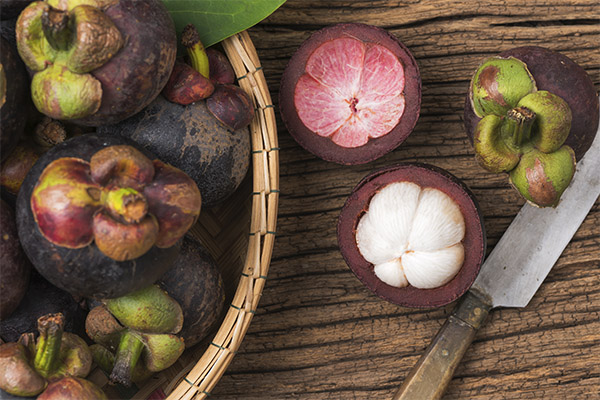
Based on the fruit, you can cook different dishes.
Fruit salad
The pulp of mangosteen is cut into small pieces, mixed with chopped pineapples, strawberries, and other Thai fruits.
Mangosteen Smoothie
Take the pulp of 2-3 fruits, cut into slices, beat in a blender with low-fat yogurt without additives. You can also add strawberries or citruses to your smoothies.
Mangosteen Jam
Take the white pulp of the fruit, chop, mix with an equal amount of brown sugar and add a little cinnamon. After boiling, the mixture is cooked for just a few minutes.
Mangosteen Sauce
Take 5-6 fruits (depending on their size), ½ teaspoon of fresh lime juice, 150 ml of boiled water, 1 teaspoon of corn starch, a mixture of spices for curry - 1 teaspoon, 3 pinch of salt, 1 pinch of sugar . Mangosteen peel. Seeds do not need to be thrown out. They can be slightly fried in a frying pan without oil and added to the sauce or to some salad. Prepare the sauce in a cauldron or pan with a non-stick bottom. Finely chopped mangosteen is poured into such a container, the mentioned seasonings and lime juice are added there, ½ cup of water is poured. The container is placed on a stove and kept on low heat until the pulp becomes completely soft. Meanwhile, corn starch is mixed with water so that it becomes homogeneous, without lumps. Water must be cold, otherwise nothing will work. When the flesh of the fruit can be mashed with a fork, then go to the final stage. Mashed fruit and spices are mixed with starch diluted with water, mixed until a homogeneous mass. You can beat everything together again with a blender and hold to thicken over low heat, but do not bring to a boil.
Three tastes mangosteen salad
This is a traditional Thai dish that can be adapted to Russian conditions. To prepare it, you will need 100 g of pineapple (but preferably fresh, not canned, since the latter is considered too sweet), 10 pcs. large boiled shrimps, ½ shallots, half a chilli pod, 7-8 cherry tomatoes, 50 ml of mangosteen sauce prepared as described above, mint leaves, 100 g boiled chicken breast. The last ingredient is often replaced with turkey, but its meat is considered drier, so more sauce may be required.
Shrimps are thawed, the shell removed from them, the hard back vein is removed, then boiled in boiling salt water for no longer than 2 minutes. Chicken breast or turkey is also pre-boiled. The pepper pod is cut into thin rings, the seeds must be removed. Chicken meat is diced. Shallots are peeled and cut into rings, and then they are divided into quarters. Cherry tomatoes are cut in half. Onions and chili in a separate bowl are mixed with mangosteen sauce. If necessary, add more lime juice and leave to brew a little.
Pieces of chicken, tomatoes, diced pineapple and whole shrimp are put in a salad bowl. Then water it all with prepared dressing and mix. Decorate it all with mint leaves.
Thai salad with mangosteen, shrimp and pork
For cooking, you will need 6–7 peeled mangosteen, 100 g of not too fatty minced pork, 8–10 large shrimps, and 2–3 shallots. This salad needs a complex sauce, which is prepared on the basis of fresh lime juice (3 tbsp. Tablespoons), traditional fish sauce (20 ml), a small amount of cayenne pepper, 1 tbsp. tablespoons of sugar without a hill and with the addition of a handful of mint leaves. Stuffing is prepared from boiled pork. Shrimp are cleaned and boiled as described above.
Mangosteen is cleaned and divided into segments. Onions are cut into thin feathers and half rings. Dressing is prepared in a separate container, mixing the ingredients so that the sugar is completely dissolved.Put all the ingredients in the salad bowl, pour over the sauce, then mix and leave for 15 minutes so that the meat and seafood are saturated with the flavors of fruit and dressing.
Mangosteen sorbet
For him, only the flesh of this fruit is needed. To prepare several servings, take 500 g of pulp. In this case, we must proceed from the fact that for 100 g there are 2-3 fruits with a peel. These fruits are peeled, the bones are taken out, and the pulp itself is whipped in a blender with a very small amount of salt. After this, the beaten pulp is sent to the refrigerator, but not to the freezer, for 30–40 minutes. Meanwhile, sugar syrup is brewed - as for ordinary sorbet. Exotic lovers can cook it not on plain water, but on coconut, especially since it is healthier and contains many minerals. So, after half an hour, beat fruit puree with syrup until a homogeneous mass is obtained. After that, she was sent to the freezer for 3 hours. Moreover, approximately every 20-30 minutes, mashed potatoes are mixed.
You can use mangosteen in cooking not only by the methods listed above. For example, juice obtained from the pulp of this fruit is added to citrus jelly. By the way, the peel of mangosteen itself, due to the content of pectins, has gelling properties. However, to remove the bitterness, heat treatment is needed.
Harm and contraindications
Mangosteen is considered one of the safest foods. Indeed, for the entire time of observation, no cases have been identified where its use would lead to negative consequences for the digestive system. But still, add it to the diet with caution.
Like any other exotic fruit, mangosteen can provoke an allergic reaction. It mainly manifests itself as a skin rash, redness, and itching. When such symptoms appear, you must immediately remove the fruit from your menu. For the same reason, it is not recommended to use it during pregnancy and lactation.
There are other limitations. It is believed that consuming large amounts of mangosteen can lower blood sugar. And although it is generally useful for diabetics, it is impossible to use it uncontrollably for this reason. The connection of hydroxycitric acid with serotonin described above also leads to the fact that this fruit cannot be combined with the administration of drugs prescribed for the treatment of depression. Indeed, paradoxically, an excess of serotonin can provoke poisoning, and quite severe.
Interestingly, studies have shown that, unlike its cousin, Garcinia cambogia, mangosteen is normally combined with green tea. But with alcohol, some hormonal drugs, agents that affect the viscosity and blood coagulation, it is not recommended to use it. In addition, due to the high content of fruit acids, it should not be included in the menu for reflux, pancreatitis, gastritis with high acidity - especially if these diseases are in the acute stage.
How to choose and store
Choosing a fresh mangosteen is not so difficult. It should have a sufficiently large size (after all, the pulp occupies only a third of the volume) and be elastic to the touch. The peel should be smooth, without flaws and not too hard.
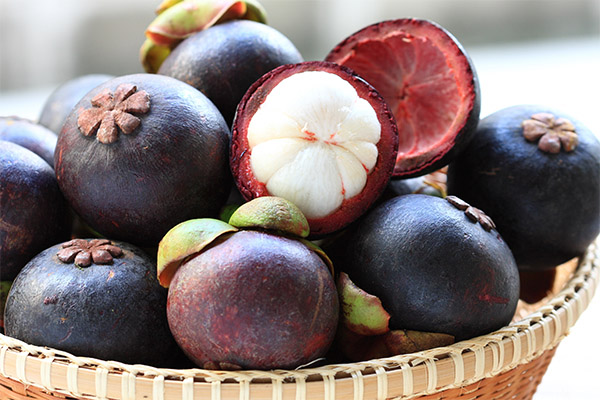
The skin color should be uniformly purple, without spots. If they appeared, this may indicate that the fruit has already been stored for too long. This is indicated by the brown tint of the upper leaves - ideally, they should be dark green. If the peel is covered with cracks, this indicates that the fruit has deteriorated. In addition, through the cracks, the bitter substances contained in the skin can penetrate the pulp, and it simply becomes tasteless.
In the refrigerator, the fetus can be stored for two weeks - if it is still peeled. It is impossible to freeze the pulp of mangosteen - it loses all its useful properties.To keep it longer than 2 weeks, you can only make syrup from it. Some experts also advise careful preservation - sterilize the fruits for no longer than 10 minutes, otherwise they will lose not only their beneficial properties, but also taste and aroma. A traditional mangosteen jam can also be stored for several months.
How to make Mangosteen ripen
This fruit ripens only on a tree; therefore, exclusively ripened fruits should be selected.
How to clean and eat mangosteen
This fruit is best eaten fresh. To do this, first get rid of the peel. The upper leaves of the fetus are opened by hand. If the fruit is ripe, just press on it with two fingers on the sides. Then it will crack, and it will be easy to remove the skin from it, under which there is a delicious pulp.
It happens that the peel itself does not crack under pressure. Then make several cuts with a knife, making sure that they are not too deep and do not damage the flesh. In general, one must proceed with caution, since on a smooth peel of the mangosteen, the knife slides strongly. After that, carefully peel the peel with a knife or fork and remove it either whole or half. From the formed half take out the pulp with a spoon.
Can I eat bones
Mangosteen bones are its seeds. They don’t eat them raw. But when fried, they are a popular seasoning of Thai cuisine.
Interesting Facts
Many legends are associated with mangosteen. Some of them interpret its name in their own way. For example, one legend says that at first the fruit was called “mangkut”. But then in some market the stranger incorrectly heard the name and decided to ask again - is it really mango. Allegedly, the seller said to him like this: mango sung-ting, which can be translated roughly like “what kind of mango is to the devil?” But “mango son-ting” has already turned into “mangosteen”, and the name began to spread further. Apparently, this is just a tourist bike, but very entertaining.

Another legend tells that for the first time Buddha came across a mangosteen in one of his wanderings. He liked the refreshing taste of the fruit so much that Buddha blessed these fruits and brought them to people - like an unprecedented gift from heaven. There is also a grain of truth in this story - mangosteen in Southeast Asia has been known since ancient times.
But the tree on which these fruits grow is truly unique. Theoretically, the mangosteen tree belongs to the number of dioecious plants, which means that some should have female flowers, while others should have male flowers. But the latter practically do not occur in nature. Therefore, female specimens have to do without pollination, and the fruits on them appear as a result of a process called agamospermia. From the seeds of such fruits grow trees, which are an exact copy of the maternal specimen.
The seeds of the mangosteen tree are considered to be very moody, they quickly die when dried, so they can only be stored in humid conditions. However, it is unlikely to grow mangosteen in Russia - even at a temperature of +20 degrees, the trees slow down their growth, and at + 5-6 degrees they die, what can we say about frosts!
Mangosteen was first brought to Europe in the 17th century, but for a long time it remained a curiosity, because then it was very difficult to keep during transportation, and a sea trip from Indonesia to Britain took several months. Therefore, it was transported literally on seedlings, and for this, ships had to organize special greenhouses and provide special conditions. It was expensive, and the fruit did not get much distribution - until recently, when air transportation made its delivery quite possible. And this is wonderful, because the fruits of the plant are very useful - just mention that out of 200 xanthons known to science, a third are contained in the mangosteen!
«Important: all information on the site is provided exclusively in fact-finding purposes. Before applying any recommendations, consult with a profile specialist. Neither the editors nor the authors are liable for any possible harm caused materials. "

